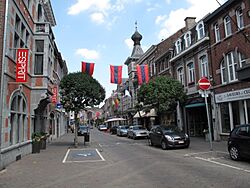Visé facts for kids
Quick facts for kids
Visé
Vizé (Walloon)
Wezet (Dutch)
|
|||
|---|---|---|---|
 |
|||
|
|||
| Country | Belgium | ||
| Community | French Community | ||
| Region | Wallonia | ||
| Province | Liège | ||
| Arrondissement | Liège | ||
| Area | |||
| • Total | 27.99 km2 (10.81 sq mi) | ||
| Population
(2018-01-01)Lua error in Module:Wd at line 1575: attempt to index field 'wikibase' (a nil value).
|
|||
| • Total | Lua error in Module:Wd at line 1,575: attempt to index field 'wikibase' (a nil value). | ||
| Postal codes |
4600-4602
|
||
| Area codes | 04 | ||
| Website | www.vise.be | ||
Visé (pronounced vee-ZAY) is a city and municipality in Wallonia, a region in Belgium. It's located right on the Meuse River in the Liège Province.
The municipality of Visé includes several smaller areas. These are called districts, and they are Argenteau, Cheratte, Lanaye, Lixhe, Richelle, and Visé itself.
Visé is quite close to other important places. It's about 20 kilometers (12.4 miles) northeast of the big Belgian city of Liège. It's also about 15 kilometers (9.3 miles) south of Maastricht, a city in the Netherlands.
The Meuse River flows through Visé, making it a scenic place. Another important waterway, the Albert Canal, also passes through the town.
Contents
Visé's Location and Neighbors
Visé is located in a special spot. To the northeast, on the east side of the Meuse River, the municipality reaches the village of Moelingen. This village is part of the Limburg region.
To the northwest, on the west side of the Meuse, Visé extends all the way to the border between Belgium and the Netherlands. Right across this border is the Dutch city of Maastricht.
A Look at Visé's Past
Visé has an interesting history, especially during wartime.
Visé During World War I
On August 4, 1914, German soldiers entered Belgium. Visé was one of the first places they reached. This was part of the beginning of the Battle of Liège.
A small group of Belgian police officers, called gendarmes, tried to stop the German advance. Sadly, two of them, Auguste Bouko and Jean-Pierre Thill, were killed. They were the first Belgian soldiers to die in World War I.
A few days later, on August 7, in the Lixhe part of Visé, German soldiers killed eleven civilians. They also destroyed eleven houses. By August 17, 1914, a total of forty-two civilians had been killed. A huge number of houses, 586 out of 840 in the village, were destroyed.
The Hasard de Cheratte Coal Mine
The coal mine of Hasard de Cheratte was an important part of the area's history. This mine was dug in the Cheratte district of Visé. It was used to dig for coal between 1850 and 1977.
Gallery
See also
 In Spanish: Visé para niños
In Spanish: Visé para niños












